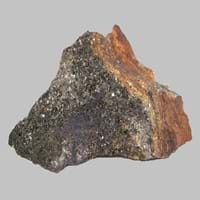Definition
Hornfels is a metamorphic rock formed by the contact between mudstone or other clay rich rock, and a hot igneous body, and represents a heat altered equivalent of the original rock
Lignite is a soft brownish coal which shows traces of plants and is intermediate between bituminous coal and peat
Origin
New Zealand
France
Discoverer
Unknown
Unknown
Etymology
From German which means hornstone
From French, Latin lignum wood + -ite1
Class
Metamorphic Rocks
Sedimentary Rocks
Sub-Class
Durable Rock, Soft Rock
Durable Rock, Soft Rock
Group
Not Applicable
Not Applicable
Other Categories
Fine Grained Rock, Opaque Rock
Coarse Grained Rock, Fine Grained Rock, Medium Grained Rock, Opaque Rock
Texture
Granular, Platy
Amorphous, Glassy
Color
Brown, Dark Greenish - Grey, Green, Reddish Brown
Black, Brown, Dark Brown, Grey, Light to Dark Grey
Durability
Durable
Durable
Appearance
Dull
Veined or Pebbled
Interior Uses
Decorative Aggregates, Flooring, Homes, Interior Decoration
Not Yet Used
Exterior Uses
As Building Stone, As Facing Stone, Garden Decoration, Office Buildings, Paving Stone
Not Yet Used
Other Architectural Uses
Curbing
Not Yet Used
Construction Industry
for Road Aggregate, Roadstone
for Road Aggregate, Steel Production
Medical Industry
Not Yet Used
Not Yet Used
Antiquity Uses
Artifacts, Monuments
Not Yet Used
Commercial Uses
Cemetery Markers, Commemorative Tablets, Creating Artwork
Electricity Generation
Types
Biotite hornfels
Xyloid Lignite or Fossil Wood and Compact Lignite or Perfect Lignite
Features
Smooth to touch
Generally rough to touch, Helps in production of Heat and Electricity, Used as fossil fuel
Archaeological Significance
Monuments
Used
Not Yet Used
Famous Monuments
Data Not Available
Not Applicable
Sculpture
Not Yet Used
Not Yet Used
Famous Sculptures
Not Applicable
Not Applicable
Figurines
Not Yet Used
Not Yet Used
Formation
Due to change in environmental conditions, rocks are heated and pressurized deep inside the Earth's surface. Hornfels is formed from the extreme heat caused by magma or by the intense collisions and friction of tectonic plates.
Coal formation takes place due to accumulation of plant debris in a swamp environment. The Coal formation process continues, as peat turns into lignite brown or black coal at increasing heat and pressure.
Mineral Content
Andalusite
Not Available
Compound Content
Fe, Mg
Carbon, Hydrogen, Nitrogen, Oxygen, Sulphur
Types of Metamorphism
Not Applicable
Not Applicable
Types of Weathering
Biological Weathering
Biological Weathering, Chemical Weathering, Mechanical Weathering
Types of Erosion
Chemical Erosion, Glacier Erosion, Sea Erosion, Water Erosion, Wind Erosion
Chemical Erosion, Water Erosion, Wind Erosion
Grain Size
Fine Grained
Medium to Fine Coarse Grained
Fracture
Conchoidal
Conchoidal
Porosity
Highly Porous
Highly Porous
Luster
Shiny
Dull to Vitreous to Submetallic
Compressive Strength
Not Available
Cleavage
Perfect
Non-Existent
Toughness
Not Yet Found
Not Available
Specific Gravity
3.4-3.9
1.1-1.4
Transparency
Opaque
Opaque
Density
0.25-0.30 g/cm3
800-801 g/cm3
Resistance
Heat Resistant, Impact Resistant, Pressure Resistant
Heat Resistant
Deposits in Eastern Continents
Asia
Bangladesh, Bhutan, China, India, North Korea, Qatar, Russia, Saudi Arabia, South Korea, Thailand
Bangladesh, Burma, Cambodia, China, India, Indonesia, Kazakhstan, Malaysia, Mongolia, Pakistan, Turkey, Vietnam
Africa
Cameroon, East Africa, Tanzania, Western Africa
Botswana, Kenya, Morocco, Mozambique, South Africa, Tanzania
Europe
United Kingdom
Belgium, Bulgaria, England, France, Germany, Greece, Hungary, Kosovo, Netherlands, Norway, Poland, Romania, Serbia, Slovakia, Slovenia, The Czech Republic, Ukraine, United Kingdom
Others
Not Yet Found
Not Yet Found
Deposits in Western Continents
North America
Canada, USA
Canada, Mexico, USA
South America
Bolivia, Brazil, Colombia, Ecuador
Brazil, Chile, Colombia, Venezuela
Deposits in Oceania Continent
Australia
New South Wales, New Zealand, Queensland, Western Australia
New South Wales, Queensland, Victoria










